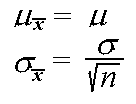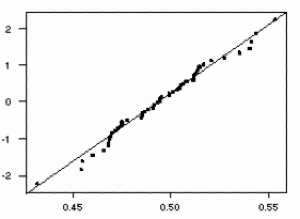Sample Means (original) (raw)
The sample mean  from a group of observations is an estimate of the population mean
from a group of observations is an estimate of the population mean  . Given a sample of size n, consider n independent random variables X1, X2, ..., Xn, each corresponding to one randomly selected observation. Each of these variables has the distribution of the population, with mean
. Given a sample of size n, consider n independent random variables X1, X2, ..., Xn, each corresponding to one randomly selected observation. Each of these variables has the distribution of the population, with mean  and standard deviation
and standard deviation  . The sample mean is defined to be
. The sample mean is defined to be  .
.
By the properties of means and variances of random variables, the mean and variance of the sample mean are the following:

Although the mean of the distribution of  is identical to the mean of the population distribution, the variance is much smaller for large sample sizes.
is identical to the mean of the population distribution, the variance is much smaller for large sample sizes.
For example, suppose the random variable X records a randomly selected student's score on a national test, where the population distribution for the score is normal with mean 70 and standard deviation 5 (N(70,5)). Given a simple random sample (SRS) of 200 students, the distribution of the sample mean score  has mean 70 and standard deviation 5/sqrt(200) = 5/14.14 = 0.35.
has mean 70 and standard deviation 5/sqrt(200) = 5/14.14 = 0.35.
Distribution of the Sample Mean
When the distribution of the population is normal, then the distribution of the sample mean is also normal. For a normal population distribution with mean  and standard deviation
and standard deviation  , the distribution of the sample mean is normal, with mean
, the distribution of the sample mean is normal, with mean  and standard deviation
and standard deviation  .
.
This result follows from the fact that any linear combinationof independent normal random variables is also normally distributed. This means that for two independent normal random variables X and Y and any constants a and b, aX + bY will be normally distributed. In the case of the sample mean, the linear combination is  = (1/n)*(X1 + X2 + ... Xn).
= (1/n)*(X1 + X2 + ... Xn).
For example, consider the distributions of yearly average test scores on a national test in two areas of the country. In the first area, the test score X is normally distributed with mean 70 and standard deviation 5. In the second area, the yearly average test score Y is normally distributed with mean 65 and standard deviation 8. The difference_X - Y_ between the two areas is normally distributed, with mean 70-65 = 5 and variance 5² + 8² = 25 + 64 = 89. The standard deviation is the square root of the variance, 9.43. The probability that area X will have a higher score than area Y may be calculated as follows:
P(X > Y) = P(X - Y > 0)
= P(((X - Y) - 5)/9.43 > (0 - 5)/9.43)
= P(Z > -0.53) = 1 - P(Z < -0.53) = 1 - 0.2981 = 0.7019.
Area X will have a higher average score than area _Y_about 70% of the time.
The Central Limit Theorem
The most important result about sample means is the Central Limit Theorem. Simply stated, this theorem says that for a large enough sample size n, the distribution of the sample mean  will approach a normal distribution. This is true for a sample of independent random variables from any population distribution, as long as the population has a finite standard deviation
will approach a normal distribution. This is true for a sample of independent random variables from any population distribution, as long as the population has a finite standard deviation  .
.
A formal statement of the Central Limit Theorem is the following:
If  is the mean of a random sample X1, X2, ... , Xn of size n from a distribution with a finite mean
is the mean of a random sample X1, X2, ... , Xn of size n from a distribution with a finite mean  and a finite positive variance
and a finite positive variance  ², then the distribution of W =
², then the distribution of W =  is _N(0,1)_in the limit as n approaches infinity.
is _N(0,1)_in the limit as n approaches infinity.
This means that the variable  is distributed N(
is distributed N( ,
, ).
).
One well-known application of this theorem is the normal approximation to the binomial distribution.
Example
Using the MINITAB "RANDOM" command with the "UNIFORM" subcommand, I generated 100 samples of size 50 each from the Uniform(0,1) distribution. The mean of this distribution is 0.5, and its standard deviation is approximately 0.3. I then applied the "RMEAN" command to calculate the sample mean across the rows of my sample, resulting in 50 sample mean values (each of which represents the mean of 100 observations). The MINITAB "DESCRIBE" command gave the following information about the sample mean data:
Descriptive Statistics
Variable N Mean Median Tr Mean StDev SE Mean C101 50 0.49478 0.49436 0.49450 0.02548 0.00360
Variable Min Max Q1 Q3 C101 0.43233 0.55343 0.47443 0.51216
The mean 0.49 is nearly equal to the population mean 0.5. The desired value for the standard deviation is the population standard deviation divided by the square root of the size of the sample (which is 10 in this case), approximately 0.3/10 = 0.03. The calculated value for this sample is 0.025. To evaluate the normality of the sample mean data, I used the "NSCORES" and "PLOT" commands to create a normal quantile plot of the data, shown below.

The plot indicates that the data follow an approximately normal distribution, lying close to a diagonal line through the main body of the points.